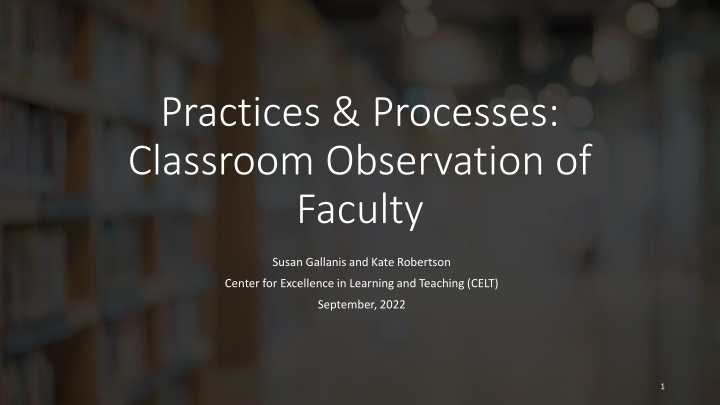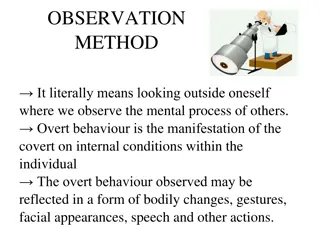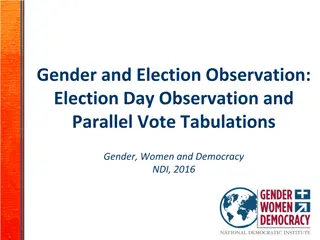Classroom Observation Practices and Processes at CELT
Classroom observation practices and processes at the Center for Excellence in Learning and Teaching (CELT) involve faculty observations, formative and summative evaluations, and the utilization of the Teaching Observation Form. Observations are conducted by various stakeholders to promote effective teaching, with documentation and follow-up meetings for feedback and improvement. The Faculty Handbook outlines the procedure for classroom visits, emphasizing the importance of ongoing instructional excellence. Access the Teaching Observation Form and additional resources on the CELT Blog.
Download Presentation

Please find below an Image/Link to download the presentation.
The content on the website is provided AS IS for your information and personal use only. It may not be sold, licensed, or shared on other websites without obtaining consent from the author.If you encounter any issues during the download, it is possible that the publisher has removed the file from their server.
You are allowed to download the files provided on this website for personal or commercial use, subject to the condition that they are used lawfully. All files are the property of their respective owners.
The content on the website is provided AS IS for your information and personal use only. It may not be sold, licensed, or shared on other websites without obtaining consent from the author.
E N D
Presentation Transcript
Practices & Processes: Classroom Observation of Faculty Susan Gallanis and Kate Robertson Center for Excellence in Learning and Teaching (CELT) September, 2022 1
History and Philosophy Scope of faculty observations Topics Teaching Observation Form and four-part observation process Resources 2
Developed and piloted in early 2019 Live July 2019 History and Philosophy Designed to promote dialogue about effective teaching 3
Formative or summative Face-to-face, virtual, online CELT, mentors, peers, chairs, program directors Faculty handbook (chairs, program directors): 4.2.B of the Faculty Handbook outlines the process for Faculty Classroom Visits, particularly the summative observations completed by an administrative representative in the first year for all new full- time faculty and once every three years for all full-time faculty. Scope of faculty observations 4
Text of 4.2.B Faculty Handbook Note that 4.2.Bof the Faculty Handbook primarily describes the summative observations which become part of the employee record. Faculty Classroom Visits (A) (Updated July 2019) As part of the university's ongoing goal to provide effective and excellent instruction, each full-time faculty member shall receive a classroom visit at least once every three years by an administrative representative. Each new full-time faculty member will receive a classroom observation (in person or via the Learning Management System for online courses) during the first year of full-time teaching at Concordia. Additional non-evaluative (formative) visits may also be made. Classroom visitation is conducted by the Vice Provost of Faculty Affairs, deans, department chairs/program directors, or peers. The "Teaching Observation Form is used to document the observation; it is found in the Forms Repository. Copies of the completed form/report shall be distributed to the faculty member observed, the department chair/program director, the dean, and the Vice Provost of Faculty Affairs. A short follow-up meeting shall take place in order for the observer to share his or her observations with the faculty member in person. A copy shall be filed in the faculty member's confidential folder in the Provost s Office. [Send the copy to the Provost Office at OfficeoftheProvost@cuw.edu] 5
The Teaching Observation Form Find on the CELT Blog (with additional resources): http://celt.cuw.edu/teaching-observation- process-and-form/ Find the form (only) in the Forms Repository of the portal 5 categories, no checklists, 3 ratings (ratings are summative only) 6
The four-part observation process: Part 1 Part 1: Pre-observation meeting (complete page 2) - explain the overall process, learn about the class, answer questions Formative observations always Summative observations sometimes Who chooses the observation date? What about online observations? Share the form with instructor 7
Part 2: The observation Objectively document what you see/hear (evidence, data) Judgement statements (negative) easy to disagree with; how can I learn from it to improve my teaching? Judgement statements (positive) feels great, but how can I use it to improve my teaching No forms during observation Notes only. The four-part observation process: Part 2 8
Take Notes During Observation: Separate Fact from Opinion Just the Facts: What is happening in the classroom What you think: Opinion, questions, suggestions 8:00 Greets class; Here is the agenda for the day 8:02 Review; What do you remember about the electoral college? - couple students in back talking how to engage them? 8:04 Other review questions: What happened during the 2000 election ? 3 students respond - nice job asking clarifying questions. Good follow up to stretch thinking. 8:07 Instructor begins video 9
Clear transitions between major topics. Consistent use of student names Good student participation Seems like face-paced talking during lecture I heard "I'm so impressed with how brilliant you are!" (students chuckling) Very organized Seems disorganized Excellent introduction! Evidence or Evaluating? I heard "In summary" at end of major topics. Nice rapport with students Instructor called on students to respond based on color of the hour Not a good storyteller Enthusiastic Included relevant examples Lecture portion of class followed the order of the learning objectives presented at start of class 10
After the observation Observer Complete pages 3 8 of the observation form Documents trends (with evidence) on the observation form. Effective? Not effective? Other options? Documents preliminary evaluation remarks (summative only) 11
Part 3: Post-observation meeting/dialogue Review notes (optional) Review the form (pages 2 8) Discuss the evidence Relate evidence to best practices Was what you observed effective? Not effective? Ask clarifying questions Summative only: At end of meeting, share ratings that will appear on the final Evaluation form as well as top 1 3 suggestions or recommendations. (No surprises) The four-part observation process: Part 3 12
What's my (opening) line? There was a clicker question and 35% answered correctly and 35% picked B (incorrect). What are some options for using this information as a learning moment? I had trouble following that story, example, etc. What was your goal with that __? (activity, slide, mini-lecture, question) How do you think that group activity went? Did it go as planned? I noticed (x) strategy for student participation. What are some other options? I've tried ___. Are you concerned about student participation? I noticed you lectured for 50 minutes straight; I noticed opportunities for students to paraphrase - Retrieval practice can be an effective learning activity. I noticed lots of students browsing internet or on their phone. 13
The four-part observation process: Part 4 Part 4: Summative observations only Complete Teaching Observation Summative Evaluation form (pages 9 11) Share with instructor Encourage instructor to complete Post- Observation Reflection (page 11) Completed and signed Teaching Observation Summative Evaluation form and Post Observation Reflection (if completed) are emailed to OfficeoftheProvost@cuw.edu. 14
Nine Principles of Good Practice Nine Principles of Good Practice How do I know what I observe is effective? Bloom's Taxonomy Bloom's Taxonomy Observation and Bloom's Taxonomy Observation and Bloom's Taxonomy (reference guide) Retrieval Practice Retrieval Practice CELT Blog Resources of Best Practices CELT Blog Resources of Best Practices 15
Thank you! 16























